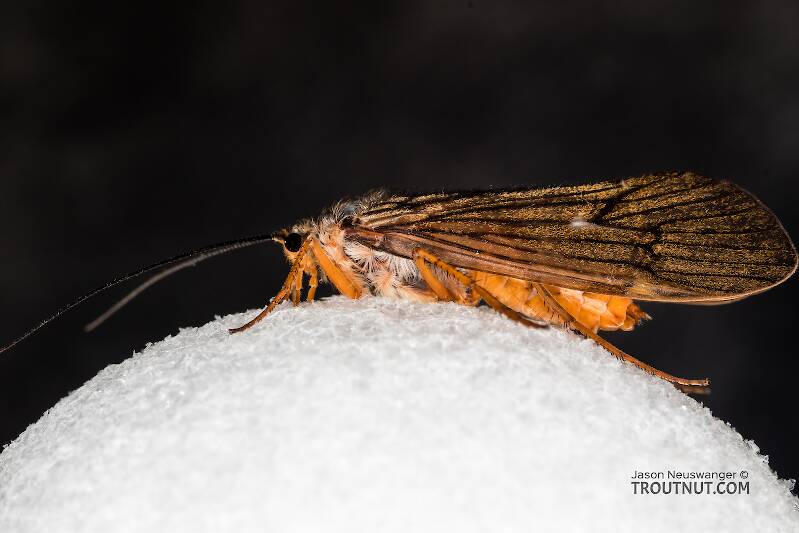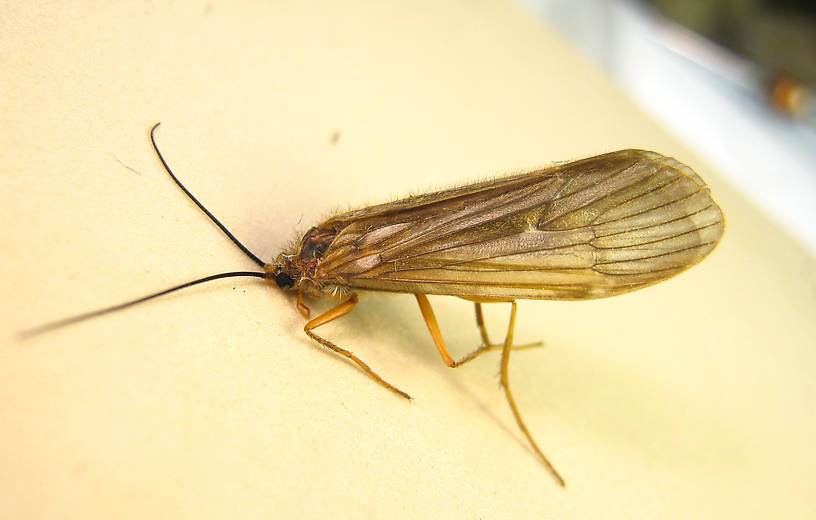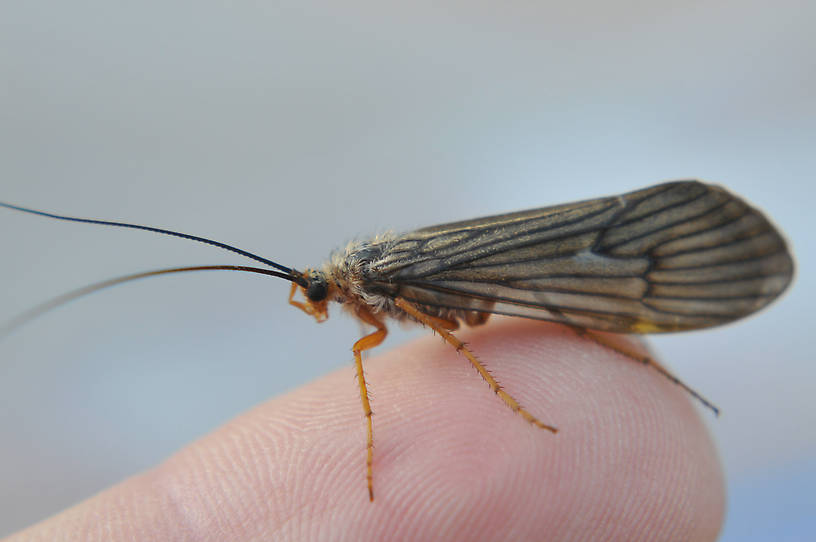
Salmonflies
Pteronarcys californica
The giant Salmonflies of the Western mountains are legendary for their proclivity to elicit consistent dry-fly action and ferocious strikes.
Featured on the forum

It's only barely visible in one of my pictures, but I confirmed under the microscope that this one has a prosternal horn and the antennae are mid-way between the eyes and front of the head capsule.
I'm calling this one Pycnopsyche, but it's a bit perplexing. It seems to key definitively to at least Couplet 8 of the Key to Genera of Limnephilidae Larvae. That narrows it down to three genera, and the case seems wrong for the other two. The case looks right for Pycnopsyche, and it fits one of the key characteristics: "Abdominal sternum II without chloride epithelium and abdominal segment IX with only single seta on each side of dorsal sclerite." However, the characteristic "metanotal sa1 sclerites not fused, although often contiguous" does not seem to fit well. Those sclerites sure look fused to me, although I can make out a thin groove in the touching halves in the anterior half under the microscope. Perhaps this is a regional variation.
The only species of Pycnopsyche documented in Washington state is Pycnopsyche guttifera, and the colors and markings around the head of this specimen seem to match very well a specimen of that species from Massachusetts on Bugguide. So I am placing it in that species for now.
Whatever species this is, I photographed another specimen of seemingly the same species from the same spot a couple months later.
I'm calling this one Pycnopsyche, but it's a bit perplexing. It seems to key definitively to at least Couplet 8 of the Key to Genera of Limnephilidae Larvae. That narrows it down to three genera, and the case seems wrong for the other two. The case looks right for Pycnopsyche, and it fits one of the key characteristics: "Abdominal sternum II without chloride epithelium and abdominal segment IX with only single seta on each side of dorsal sclerite." However, the characteristic "metanotal sa1 sclerites not fused, although often contiguous" does not seem to fit well. Those sclerites sure look fused to me, although I can make out a thin groove in the touching halves in the anterior half under the microscope. Perhaps this is a regional variation.
The only species of Pycnopsyche documented in Washington state is Pycnopsyche guttifera, and the colors and markings around the head of this specimen seem to match very well a specimen of that species from Massachusetts on Bugguide. So I am placing it in that species for now.
Whatever species this is, I photographed another specimen of seemingly the same species from the same spot a couple months later.

Troutnut is a project started in 2003 by salmonid ecologist Jason "Troutnut" Neuswanger to help anglers and
fly tyers unabashedly embrace the entomological side of the sport. Learn more about Troutnut or
support the project for an enhanced experience here.
This topic is about the Caddisfly Genus Dicosmoecus
This is a superhatch in the West. Gary LaFontaine had a self-proclaimed obsession with Dicosmoecus, and he devotes several pages of Caddisflies to stressing the importance of its larvae, pupae, and adults. He wrote:The question for fly fishermen seeking big trout is: "Which insects provide the best opportunity for catching such fish?" My list would be: Giant Orange Sedge (Dicosmoecus sp.), Salmon Fly (Pteronarcys californica, a stonefly), and the Michigan Mayfly (Hexagenia limbata). Dicosmoecus is the most important -- and the contest is not even close.
His reasons for this judgement are five traits of Dicosmoecus:
- Very large size: Adults 30mm long, and thick.
- Activity concentrated within 2-3 weeks.
- Emerges in the low, clear water of fall.
- Active during afternoon and evening.
- Abundant in rivers with sea-run trout.
Personally I have only caught a good Dicosmoecus hatch one time, and on a secret desert spring creek. It reminded me of fishing Isonychia mayfly hatches back east, because there weren't enough bugs around to have trout rising consistently, but the presence of a particularly good food source in low numbers for a long time had them on the lookout for imitations. I had big trout cartwheeling out of the water to smash actively-fished imitations.
Example specimens
Troutnut on Aug 22, 2006August 22nd, 2006, 3:42 pm EDT
There's a good topic with people sharing their experiences with Dicosmoecus over at the Washington Fly Fishing Forum.
Jason Neuswanger, Ph.D.
Troutnut and salmonid ecologist
Troutnut and salmonid ecologist
Taxon on Aug 22, 2006August 22nd, 2006, 7:40 pm EDT
Jason-
In case you're not familiar with the cast of characters on WFF, that particular thread drew several pretty savvy members. Preston is Preston Singletary a columnist with Flyfishing & Tying Journal. Smamla (as in S. malma) is Curt Kramer, a retired WDFW fisheries biologist and renowned Bull Trout enthusiast.
In case you're not familiar with the cast of characters on WFF, that particular thread drew several pretty savvy members. Preston is Preston Singletary a columnist with Flyfishing & Tying Journal. Smamla (as in S. malma) is Curt Kramer, a retired WDFW fisheries biologist and renowned Bull Trout enthusiast.
Quick Reply
Related Discussions
Topic
Replies
Last Reply
26
Feb 5, 2016
by Martinlf
by Martinlf
3
Jul 3, 2007
by JeffK
by JeffK
14
Jul 24, 2014
by Crepuscular
by Crepuscular
10
Dec 21, 2007
by Creno
by Creno
19
Oct 24, 2008
by Jack_k
by Jack_k
23
Nov 8, 2007
by Lam
by Lam
14
Sep 26, 2013
by Crepuscular
by Crepuscular






